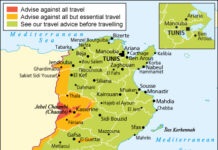In the year 2000, during my J1 summer in New York, I took a late evening bus from the Avenue of the Americas in the heart of Manhattan to Riverdale, in the Bronx, where my granduncle lived.
eside me on the journey sat a middle-aged woman with a pile of legal papers on her lap. As the skyscrapers shuttled by the window, she asked me about my summer and I told her that I had been working as a waiter on Fire Island, a famous resort, kind of like a gay Hamptons, off the coast of Long Island. She sighed enviously, told me she was a lawyer and added that for every day of the office grind she missed her “carefree” days as a student waitress.
I thought back to the previous weeks of 17-hour work days, aching feet, stolen tips, and hard-bitten people, and decided whatever else happened in life I would never succumb to such pathological nostalgia.
But time, ageing and adult responsibilities do truly weird things to the brain. Two decades, three recessions, a pandemic and a zillion deadlines later, I too get weirdly soppy about the memories of simpler times, ferrying cocktails and stuffing tips in my shorts. I missed that feeling of being feckless and optimistic.
And so, over the lockdowns, a plan coalesced: I would return to Fire Island, bringing my partner Rory with me this time, and combine it with a few days in Manhattan. So as summer drew to a close, that’s what we did.
After taking an Aer Lingus flight to New York JFK and enjoying the city’s busy sights and sounds, we felt we’d earned a few days at the beach.
It’s a two-hour journey from Penn Station to Sayville, from where the ferry to Fire Island departs. Since the 1930s, when artists like Paul Cadmus and Jared and Margaret French rented a house and staged photographic exhibitions under the name PaJaMa, the beauty of the island’s landscape has brought holidaymakers from Manhattan.
Many of these were gay, and the resort became a favourite with the artistic and creative crowd. By the time I arrived for my J1 summer, the island had beceme a weekend bolthole for stars like Calvin Klein and David Geffen, who had houses there.
One of the first things we saw as we docked in the Pines was a huge tribute picture of my old boss. John Whyte was a male supermodel in the 1950s and he and his companion – former showgirl Peggy Fears – owned not just the main restaurant and hotel (aka The Botel) in the Pines, but the very boardwalk on which we walked from one to the other.
Next door to The Botel was The Pavilion nightclub, the near-mythic disco venue. In the 1980s and 90s, Madonna and Whitney Houston would helicopter out from Manhattan to dance there.
Whyte adored a hyper masculine and preppy style in gay men and, according to local lore, had once refused a drag queen entry to high tea – a kind of afternoon cocktail hour. The drag queen returned with several of her friends. Eventually all were admitted and the event became an annual tradition called ‘the invasion’, during which a boat full of drag queens storm the barricades and do their thing as a DJ plays.
For the Pines crowds, this event was as big as the fourth of July and I once weaved amid a sea of wigs working at the nearby restaurant the Yacht Club, tray in hand.
Since Whyte died in 2004, a group of younger entrepreneurs have taken over, but this new iteration of the Pines has faced problems: an accidental blaze lent a bitter irony to the island’s name and destroyed the Pavilion 10 years ago.
The island – which is less than a mile wide at any given point – has also been changed forever by the battering it received from hurricane Sandy in 2012. A huge federal programme funded the construction of a new sand barrier and certain homeowners moved their pads back a few hundred yards from the coast.
These new beachfront houses, most of them packed with people renting them in strictly regimented timeshares, loom like deserted mausoleums and become gradually more homely the closer you get to Cherry Grove – a mainly lesbian area a couple of miles down the coast.
Today, the whole place is a strange mixture of suburban manicuring and lush nature reserve. When one venue opens another closes and the crowds disperse and reform like a murmuration.
Now that the whole world has gone queer – there are even rainbow flags fluttering above Irish bars in Manhattan – Fire Island doesn’t quite seem the glamorously illicit destination it once was.
But there are still thrilling little signs you’ve entered a parallel universe: a general store selling ‘boy smells’ and industrial strength lube, someone arriving for high tea in assless chaps and knee-high boots, the wonderful feeling of being in a place without cars or roads.
The crowd were corporate misfits, some of whom were out-and-proud ‘digital nomads’ and had brought their work to the beach (the noxious noise pollution of morning conference calls was audible from our room).
And technology had tamed another formerly key element of the Pines. Like film director John Waters, I wondered: ‘Where are the perverts?’ Those guys who would prowl the balconies of The Botel like stray cats in heat and caused an area of nearby woodland to be rechristened ‘the meat rack’.
“Oh nobody needs to do that any more,” one of the afternoon drinkers at the Yacht Club informed me, dryly. “They’re all on apps now.”
We were there just after Labour Day and the high season crowd had thinned out a bit: though the winter utilities are shut off in most areas and the place is deserted. With the sun setting and sunburn glowing beneath our shirts, it felt like five-to-midnight for summer 2022.
I thought of the last time I left the island, when just weeks later I would be living and studying in yet another world – the centre of Berlin – and I felt a surge of yearning for the freedom of being 20 again and an innocent abroad in this debauched paradise.
But then I remembered the flip side of being young in the Noughties: the insecurity, the lack of a clue about anything, and the bootcut jeans, and I thought: ‘Dear me, no.’
Amid the rekindling of J1 memories, Manhattan, too, was a kind of reunion for me. On this visit, we stayed at the welcoming Fitzpatrick Hotel on Lexington Avenue, the Irish-owned outfit which has long stood as a beacon of hospitality and American promise.
But for three years, a decade ago, I lived in an old brownstone in the East Village. At the time, the locals were already lamenting how gentrified this once scruffy artist’s quarter had become (a process that began with Rudolph Giuliani’s clean-up of the city in the 1990s).
Ironically, those years – with rents kept reasonable in the aftermath of the economic crash – now represent a lost Bohemia. The spiralling cost of living – a bagel and a coffee set me back $26 on Tompkins Square Park in the heart of the village – and metastasising rents (an average of $4k a month for a one-bed) have made it the preserve of the very wealthy.
If seeing the old ‘hood prompted a little pang – John Steinbeck wrote that after you live in New York “nowhere else will do” – there was an exhilaration in seeing the island come back to life. The canyons of Times Square and Rockefeller Center which lay silent and empty barely a year ago once again teemed with tourists.
The downtown restaurant scene has moved almost entirely outdoors, with bars and restaurants colonising the pavements, billowing with clouds of steam and the constant waft of marijuana, now legalised in New York.
The High Line, a path which begins in the Meatpacking District and runs up the West Side, is a smorgasbord of visual wonders, including The Shed, an architectural spectacle with a shimmering steel exoskeleton framing interior elevators that twist and curve like vines.
From there we biked over the Manhattan Bridge (easier than the Brooklyn Bridge with its throngs of dawdling pedestrians) and into Dumbo. We braved a reassuringly long queue – long lines are the New York metric of quality – to sample the fare, a kind of Southern Sunday roast, at Hometown BBQ.
The most surprising things about Manhattan are that, despite the millions of people crammed into an island that is just two miles wide, it’s still a village and that despite the famous gruffness of its residents, there is a pulse of kindness at the heart of the metropolis.
On the last night in the city I bumped into old friends at an old haunt on 14th street. Their life’s journeys, from the poverty of rural Texas, and the heart of Soviet Russia, all the way to the East Village, had been even more epic than my own from suburban Dublin and they were my community when I lived there.
Seeing their faces was the climax of what turned into – despite my earlier convictions – a pilgrimage of nostalgia. You can grow up and grow away from your youth, you can try not to look back, but everything that comes later has the taint of aftermath.
Getting there
- Aer Lingus operates three daily flights from Dublin to New York, as well as a daily flight from Shannon, with fares starting from €179 each way including taxes and charges; Dublin – JFK (twice daily); Dublin – Newark; Shannon – JFK. For more information visit aerlingus.com.
- The best rates for Fitzpatrick’s hotels are at its website, while the best current promotion is Stay Long, Save Bigger – if you stay four nights or more you receive 10pc off the normal rate. fitzpatrickhotels.com







